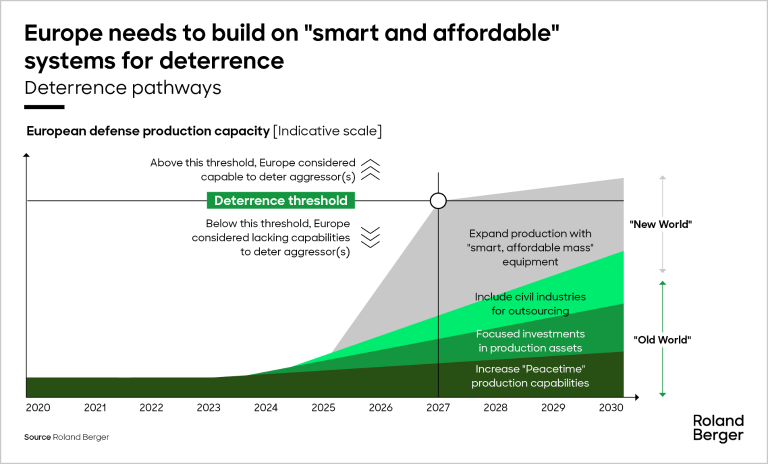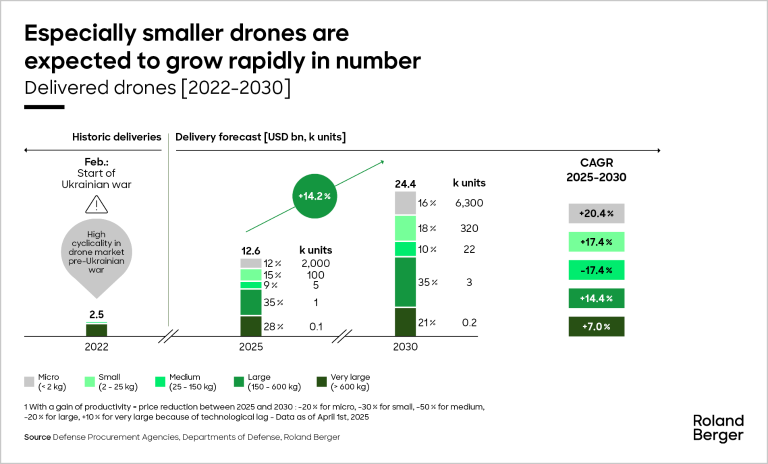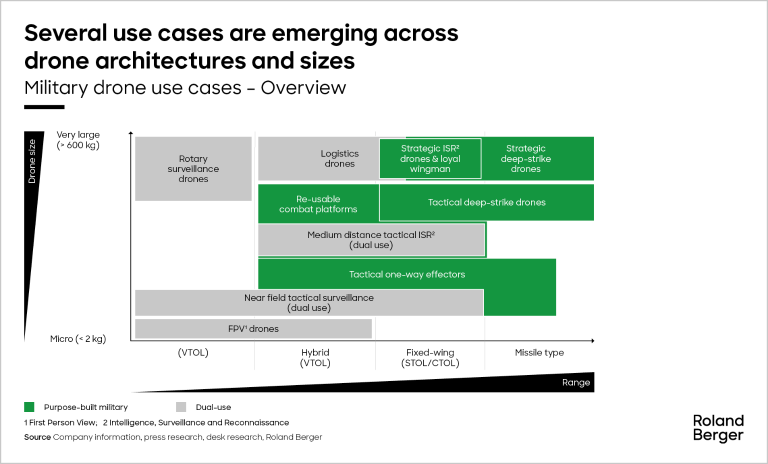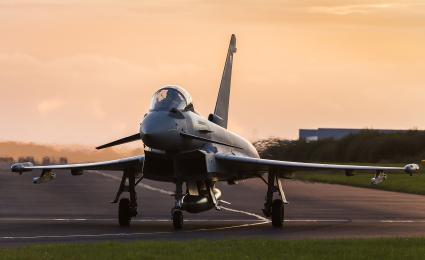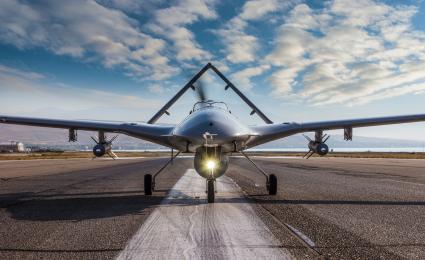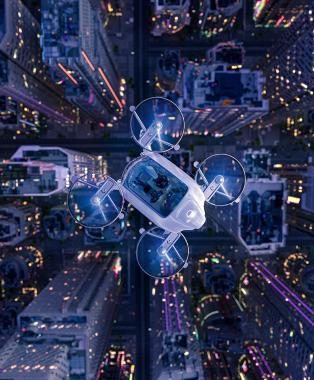European security is under threat. A new report from Roland Berger examines what Europe must do to achieve sustainable deterrence and protect its core interests.


Smart and affordable mass
By Stephan Baur
How military drones redefine defense in Europe
Global defense is undergoing a profound transformation. The war in Ukraine has shown the decisive role of drones in modern warfare: From reconnaissance quadcopters to long-range strike drones, unmanned systems now shape both battlefield dynamics and strategic deterrence. Russia and Ukraine have demonstrated not only the scale but also the speed at which drone technology evolves under conflict conditions. Innovation cycles are now counted in weeks rather than years.
In this environment, the concept of smart and affordable mass has emerged as a critical paradigm. Instead of focusing solely on high-end, expensive assets, militaries are now investing in large numbers of drones that are cost-efficient, adaptable, and rapidly producible. This shift is changing the economics of war — and it is especially relevant for Europe, which faces both budgetary pressure and a growing urgency to close capability gaps.
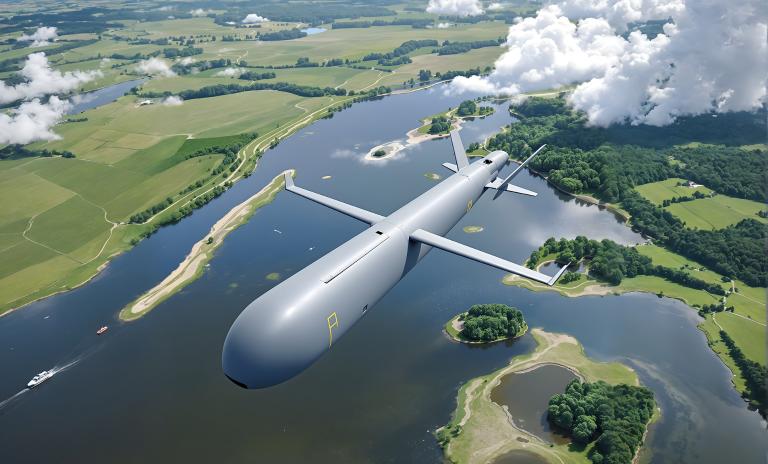
"Smart affordable mass and in particular aerial drones are on the rise. This provides new market opportunities also for players outside of Aerospace & Defense."
The rise of drones in modern warfare
Drones are no longer niche systems but central to contemporary military operations. In Ukraine, unmanned aerial systems have been used daily for surveillance, electronic warfare, logistics, and precision strikes. First-person-view (FPV) drones costing a few thousand dollars have successfully destroyed multi-million-dollar armored vehicles, altering the cost-benefit balance of battlefield engagements and reducing the need for physical human presence.
Russia has relied heavily on Shahed-type drones to sustain long-range strike campaigns. Initially produced in other countries such as Iran, Russia is now able to produce these drones domestically. Ukraine has pioneered an ecosystem of decentralized drone production and continuous frontline innovation, resulting in a new model of defense capability that prioritizes scale, affordability, and adaptability.
The lessons are clear. Innovation cycles have accelerated dramatically, with drones being redesigned, tested, and deployed within weeks rather than years. Civil-military integration has become a force multiplier, with commercial components, open-source software, and civilian industries supporting rapid scaling. Finally, drones are proving operationally flexible, deployed across missions ranging from tactical intelligence, surveillance, and reconnaissance (ISR) to strategic deep strike.
Why “smart and affordable mass” matters
Traditional defense systems are designed for superior performance, but they are often too costly and too slow to produce at the required scale. Smart and affordable drones can help fill this gap by delivering acceptable performance at a fraction of the cost of legacy systems, enabling mass deployment at the scale required for modern deterrence.
Crucially, large drone fleets allow militaries to cross the deterrence threshold – the point at which an adversary recognizes aggression as too costly or unlikely to succeed. Their modular payloads and software-defined architectures make them highly adaptable, enabling rapid role changes between surveillance, strike, and electronic warfare. In this way, affordable drones provide the quantity to complement the quality of advanced systems such as fighter jets, tanks, and air-defense assets, creating more layered resilience in defense planning.
Changing the economics of war
The battlefield is no longer dominated solely by the most advanced or expensive systems. Instead, power lies with the force that can combine technology, scale, and adaptability. Ukraine’s ability to deploy thousands of drones at low cost vividly illustrates this shift.
In some cases, medium-strike drones have replaced traditional artillery, offering longer reach with precision. Logistics drones have kept frontline units supplied in environments where traditional vehicles could not operate.
The strategic implication is profound: The side that achieves affordable mass production of drones can impose unsustainable costs on its adversary. With Europe currently lagging behind in scalable drone production, catching up is an urgent strategic necessity.
Industrial and strategic trends
Building smart and affordable mass requires Europe to respond to several converging trends. Mass deployment and scalable production demand a shift from bespoke, hand-built drones to industrialized production lines able to make tens of thousands of units annually. This is more akin to requirements in industries such as automotive, with integrated flexibility to rapidly scale up in times of need. Civil–military integration is essential, drawing on commercial drone expertise and dual-use supply chains to accelerate scaling. Supply chain resilience must be secured by reducing dependency on imported components, in particular from China but also other countries, and ensuring access to critical technologies in propulsion, navigation, and communications.
Equally important is the integration of drones into manned–unmanned teaming concepts, extending the reach of aircraft and ground systems and enhancing survivability. Finally, drone concepts are expanding across domains, with maritime and land-based systems contributing to multi-domain deterrence.
Europe’s defense imperative
Europe finds itself in an environment of existential threat , exemplified by Russia’s assertive posture and the ever-present risk of broader conflict. Although defense budgets are on the rise, sustainable deterrence requires more than financial resources – it demands a holistic approach suited to evolving warfare paradigms. Old assumptions, built on small and ultra-sophisticated arsenals, no longer suffice. Adversaries have already shifted their industrial bases to wartime footing, directing full-scale production of large volumes of military capabilities. Europe must therefore scale quickly, implement continuous upgrades, and remain agile in the face of shifting threats.
Four industrial pathways are central to this challenge. A robust European defense technology and industrial base must integrate all four to maximize resilience.
- Steady peacetime production, which provides a baseline when tensions are low but ensures readiness.
- Targeted capital investment to modernize existing supply lines, enabling a swift increase in output when required.
- Collaboration with civilian industries, which can provide high-volume manufacturing capacity and resolve bottlenecks in supply chains.
- Increased focus on smart and affordable mass, leveraging software-defined solutions and modular architectures that scale rapidly and update continuously in response to changing threats.
Reaching the deterrence threshold will also require clear priority-setting. Policymakers and defense agencies must unify doctrines and refine procurement programs to avoid fragmentation. Defense companies need to reshape operating models, accelerate development cycles, and adopt more agile designs. Non-defense firms, from automotive suppliers to electronics manufacturers, should be mobilized to provide additional capacity for traditional platforms and high-volume production of drones and other unmanned systems.
Ultimately, only a coordinated effort across ministries, industry, and civil sectors can provide the resilience and capabilities Europe needs. By acting decisively now, Europe can secure the industrial and innovative foundations to deter aggression and protect its core security interests in an increasingly uncertain world.
Act now: Building deterrence through smart and affordable mass
The lesson from Ukraine is clear: future wars will not be won by a handful of exquisite systems, but by the ability to field resilient, affordable, and adaptable capabilities at scale. For Europe, embracing smart and affordable mass in drones is essential to cross the deterrence threshold and ensure credible defense in an uncertain world.
At Roland Berger, we support defense ministries, industry leaders, and investors in shaping strategies to build this new capability. From market analysis and industrial ramp-up planning to procurement strategies and cross-sector collaboration, we help clients translate the concept of smart and affordable mass into actionable reality.
Contact us today to explore how Europe can secure its future defense through scalable drone innovation.


